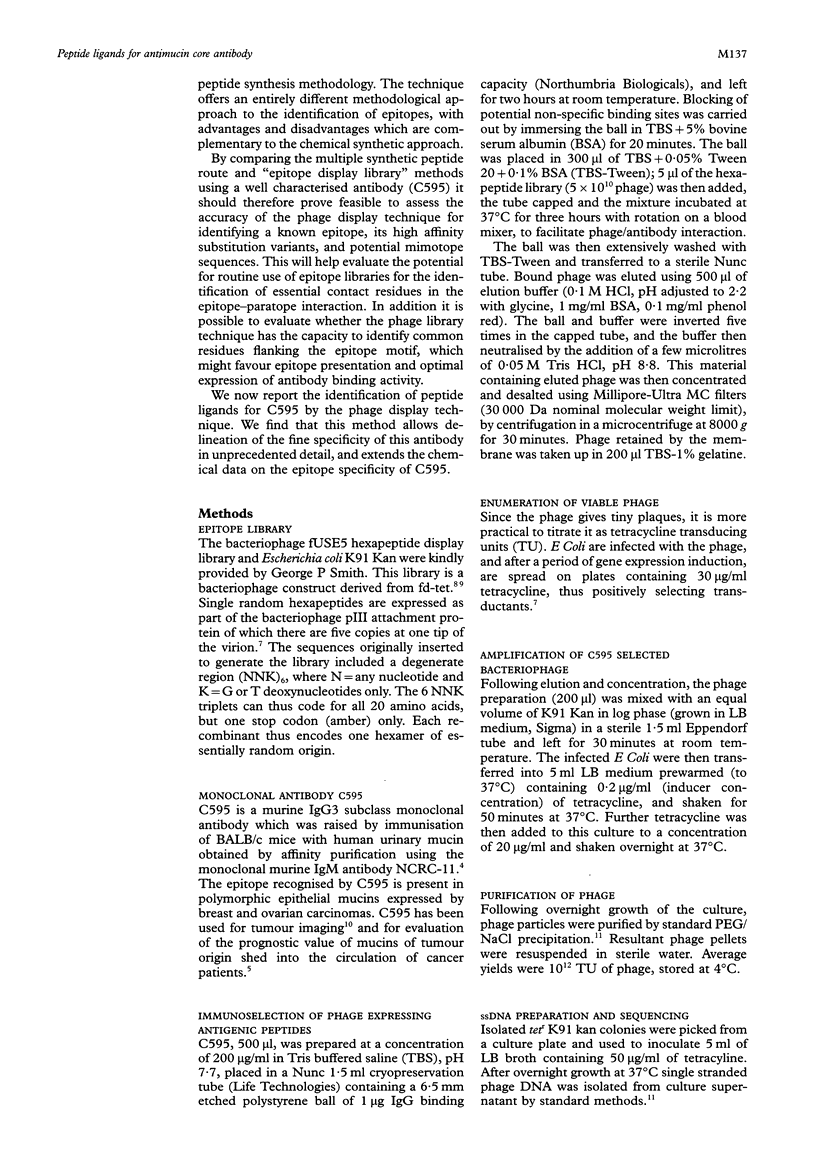Abstract
Aims—To further define the specificity of the antimucin core antibody C595 by fitting it with a family of hexapeptide ligands by immunoselection of filamentous bacteriophage from a gene III display library of approximately 6·4 × 107 random hexapeptides.
Methods—Three rounds of immuno-selection were used to enrich for C595 binding phage. DNA sequencing revealed the hexapeptides expressed. Bacteriophage and corresponding synthetic hexapeptides were used in ELISA assay to determine binding affinities.
Results—Twenty nine clones from this selected population were analysed. Seven contained the natural epitope RPAP, encoded by two different DNA sequences; 17/29 contained the motif RLPP. In all, 28/29 clones contained the motif RXXP and one clone (RVRPAP) contained the motif RXXP in two peptidic registers; 24/28 clones (6/8 DNA sequences) contained a hydrophobic residue (V or I) at position 1 relative to the RXXP motif. In addition the proximity of RXXP to glycine (position 5) suggests that this contributes in the natural epitope to antibody/antigen binding, which was not detected by chemical synthetic methods. One clone, KSKAGV, bears no obvious relationship to the natural epitope and therefore qualifies as a weakly binding mimotope.
Conclusions—This approach has rapidly defined the specificity of this antibody in unprecedented detail, and provides a more comprehensive molecular basis for exploring the immune recognition of the MUC1 mucin by the C595 antibody. Importantly, the novel but related epitopes seen provide peptide specificities and a strategy which may prove useful in generating cancer vaccine candidates.
Keywords: MUC1 mucin
Keywords: epitope library
Keywords: peptide
Full text
PDF





Selected References
These references are in PubMed. This may not be the complete list of references from this article.
- Briggs S., Price M. R., Tendler S. J. Fine specificity of antibody recognition of carcinoma-associated epithelial mucins: antibody binding to synthetic peptide epitopes. Eur J Cancer. 1993;29A(2):230–237. doi: 10.1016/0959-8049(93)90181-e. [DOI] [PubMed] [Google Scholar]
- Burchell J., Taylor-Papadimitriou J., Boshell M., Gendler S., Duhig T. A short sequence, within the amino acid tandem repeat of a cancer-associated mucin, contains immunodominant epitopes. Int J Cancer. 1989 Oct 15;44(4):691–696. doi: 10.1002/ijc.2910440423. [DOI] [PubMed] [Google Scholar]
- Ding L., Lalani E. N., Reddish M., Koganty R., Wong T., Samuel J., Yacyshyn M. B., Meikle A., Fung P. Y., Taylor-Papadimitriou J. Immunogenicity of synthetic peptides related to the core peptide sequence encoded by the human MUC1 mucin gene: effect of immunization on the growth of murine mammary adenocarcinoma cells transfected with the human MUC1 gene. Cancer Immunol Immunother. 1993;36(1):9–17. doi: 10.1007/BF01789125. [DOI] [PMC free article] [PubMed] [Google Scholar]
- Gendler S., Taylor-Papadimitriou J., Duhig T., Rothbard J., Burchell J. A highly immunogenic region of a human polymorphic epithelial mucin expressed by carcinomas is made up of tandem repeats. J Biol Chem. 1988 Sep 15;263(26):12820–12823. [PubMed] [Google Scholar]
- Geysen H. M., Rodda S. J., Mason T. J., Tribbick G., Schoofs P. G. Strategies for epitope analysis using peptide synthesis. J Immunol Methods. 1987 Sep 24;102(2):259–274. doi: 10.1016/0022-1759(87)90085-8. [DOI] [PubMed] [Google Scholar]
- Hudecz F., Price M. R. Monoclonal antibody binding to peptide epitopes conjugated to synthetic branched chain polypeptide carriers. Influence of the carrier upon antibody recognition. J Immunol Methods. 1992 Mar 4;147(2):201–210. doi: 10.1016/s0022-1759(12)80009-3. [DOI] [PubMed] [Google Scholar]
- Longenecker B. M., Reddish M., Koganty R., MacLean G. D. Specificity of the IgG response in mice and human breast cancer patients following immunization against synthetic sialyl-Tn, an epitope with possible functional significance in metastasis. Adv Exp Med Biol. 1994;353:105–124. doi: 10.1007/978-1-4615-2443-4_11. [DOI] [PubMed] [Google Scholar]
- MacLean G. D., Reddish M., Koganty R. R., Wong T., Gandhi S., Smolenski M., Samuel J., Nabholtz J. M., Longenecker B. M. Immunization of breast cancer patients using a synthetic sialyl-Tn glycoconjugate plus Detox adjuvant. Cancer Immunol Immunother. 1993;36(4):215–222. doi: 10.1007/BF01740902. [DOI] [PMC free article] [PubMed] [Google Scholar]
- Parmley S. F., Smith G. P. Antibody-selectable filamentous fd phage vectors: affinity purification of target genes. Gene. 1988 Dec 20;73(2):305–318. doi: 10.1016/0378-1119(88)90495-7. [DOI] [PubMed] [Google Scholar]
- Perkins A. C., Symonds I. M., Pimm M. V., Price M. R., Wastie M. L., Symonds E. M. Immunoscintigraphy of ovarian carcinoma using a monoclonal antibody (111In-NCRC48) defining a polymorphic epithelial mucin (PEM) epitope. Nucl Med Commun. 1993 Jul;14(7):578–586. doi: 10.1097/00006231-199307000-00011. [DOI] [PubMed] [Google Scholar]
- Price M. R., Briggs S., Scanlon M. J., Tendler S. J., Sibley P. E., Hand C. W. The mucin antigens: what are we measuring? Dis Markers. 1991 May-Aug;9(3-4):205–212. [PubMed] [Google Scholar]
- Price M. R., Hudecz F., O'Sullivan C., Baldwin R. W., Edwards P. M., Tendler S. J. Immunological and structural features of the protein core of human polymorphic epithelial mucin. Mol Immunol. 1990 Aug;27(8):795–802. doi: 10.1016/0161-5890(90)90089-i. [DOI] [PubMed] [Google Scholar]
- Swallow D. M., Gendler S., Griffiths B., Corney G., Taylor-Papadimitriou J., Bramwell M. E. The human tumour-associated epithelial mucins are coded by an expressed hypervariable gene locus PUM. Nature. 1987 Jul 2;328(6125):82–84. doi: 10.1038/328082a0. [DOI] [PubMed] [Google Scholar]
- Wreschner D. H., Hareuveni M., Tsarfaty I., Smorodinsky N., Horev J., Zaretsky J., Kotkes P., Weiss M., Lathe R., Dion A. Human epithelial tumor antigen cDNA sequences. Differential splicing may generate multiple protein forms. Eur J Biochem. 1990 May 20;189(3):463–473. doi: 10.1111/j.1432-1033.1990.tb15511.x. [DOI] [PubMed] [Google Scholar]
- Zacher A. N., 3rd, Stock C. A., Golden J. W., 2nd, Smith G. P. A new filamentous phage cloning vector: fd-tet. Gene. 1980 Apr;9(1-2):127–140. doi: 10.1016/0378-1119(80)90171-7. [DOI] [PubMed] [Google Scholar]


